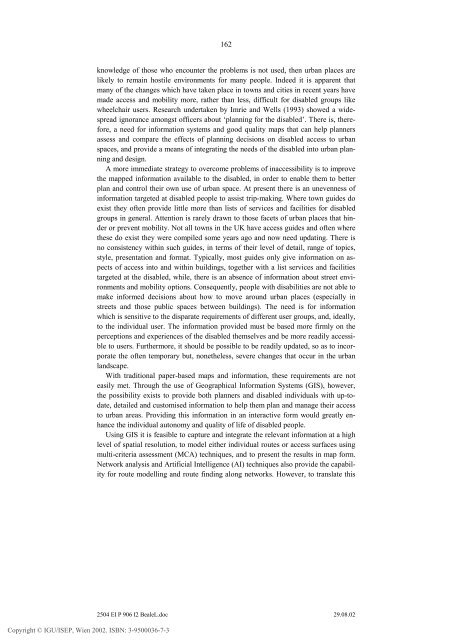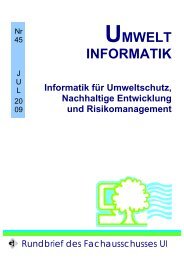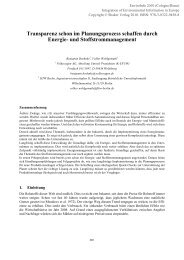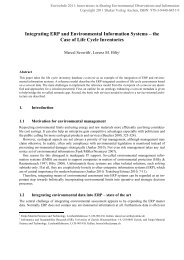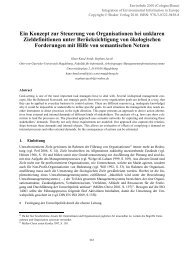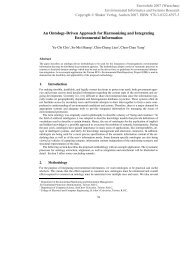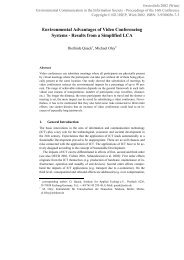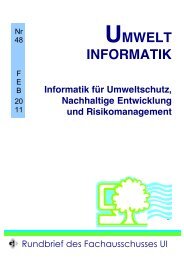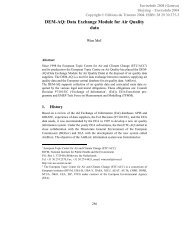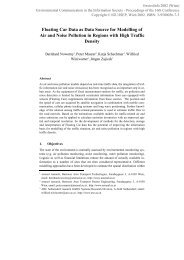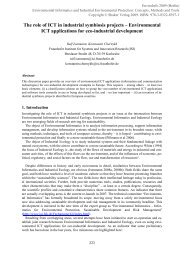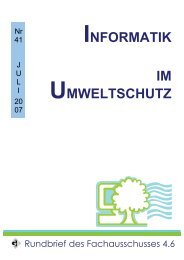A GIS-based Route Mapping Tool for Disabled Access in Urban ...
A GIS-based Route Mapping Tool for Disabled Access in Urban ...
A GIS-based Route Mapping Tool for Disabled Access in Urban ...
Create successful ePaper yourself
Turn your PDF publications into a flip-book with our unique Google optimized e-Paper software.
162knowledge of those who encounter the problems is not used, then urban places arelikely to rema<strong>in</strong> hostile environments <strong>for</strong> many people. Indeed it is apparent thatmany of the changes which have taken place <strong>in</strong> towns and cities <strong>in</strong> recent years havemade access and mobility more, rather than less, difficult <strong>for</strong> disabled groups likewheelchair users. Research undertaken by Imrie and Wells (1993) showed a widespreadignorance amongst officers about ‘plann<strong>in</strong>g <strong>for</strong> the disabled’. There is, there<strong>for</strong>e,a need <strong>for</strong> <strong>in</strong><strong>for</strong>mation systems and good quality maps that can help plannersassess and compare the effects of plann<strong>in</strong>g decisions on disabled access to urbanspaces, and provide a means of <strong>in</strong>tegrat<strong>in</strong>g the needs of the disabled <strong>in</strong>to urban plann<strong>in</strong>gand design.A more immediate strategy to overcome problems of <strong>in</strong>accessibility is to improvethe mapped <strong>in</strong><strong>for</strong>mation available to the disabled, <strong>in</strong> order to enable them to betterplan and control their own use of urban space. At present there is an unevenness of<strong>in</strong><strong>for</strong>mation targeted at disabled people to assist trip-mak<strong>in</strong>g. Where town guides doexist they often provide little more than lists of services and facilities <strong>for</strong> disabledgroups <strong>in</strong> general. Attention is rarely drawn to those facets of urban places that h<strong>in</strong>deror prevent mobility. Not all towns <strong>in</strong> the UK have access guides and often wherethese do exist they were compiled some years ago and now need updat<strong>in</strong>g. There isno consistency with<strong>in</strong> such guides, <strong>in</strong> terms of their level of detail, range of topics,style, presentation and <strong>for</strong>mat. Typically, most guides only give <strong>in</strong><strong>for</strong>mation on aspectsof access <strong>in</strong>to and with<strong>in</strong> build<strong>in</strong>gs, together with a list services and facilitiestargeted at the disabled, while, there is an absence of <strong>in</strong><strong>for</strong>mation about street environmentsand mobility options. Consequently, people with disabilities are not able tomake <strong>in</strong><strong>for</strong>med decisions about how to move around urban places (especially <strong>in</strong>streets and those public spaces between build<strong>in</strong>gs). The need is <strong>for</strong> <strong>in</strong><strong>for</strong>mationwhich is sensitive to the disparate requirements of different user groups, and, ideally,to the <strong>in</strong>dividual user. The <strong>in</strong><strong>for</strong>mation provided must be <strong>based</strong> more firmly on theperceptions and experiences of the disabled themselves and be more readily accessibleto users. Furthermore, it should be possible to be readily updated, so as to <strong>in</strong>corporatethe often temporary but, nonetheless, severe changes that occur <strong>in</strong> the urbanlandscape.With traditional paper-<strong>based</strong> maps and <strong>in</strong><strong>for</strong>mation, these requirements are noteasily met. Through the use of Geographical In<strong>for</strong>mation Systems (<strong>GIS</strong>), however,the possibility exists to provide both planners and disabled <strong>in</strong>dividuals with up-todate,detailed and customised <strong>in</strong><strong>for</strong>mation to help them plan and manage their accessto urban areas. Provid<strong>in</strong>g this <strong>in</strong><strong>for</strong>mation <strong>in</strong> an <strong>in</strong>teractive <strong>for</strong>m would greatly enhancethe <strong>in</strong>dividual autonomy and quality of life of disabled people.Us<strong>in</strong>g <strong>GIS</strong> it is feasible to capture and <strong>in</strong>tegrate the relevant <strong>in</strong><strong>for</strong>mation at a highlevel of spatial resolution, to model either <strong>in</strong>dividual routes or access surfaces us<strong>in</strong>gmulti-criteria assessment (MCA) techniques, and to present the results <strong>in</strong> map <strong>for</strong>m.Network analysis and Artificial Intelligence (AI) techniques also provide the capability<strong>for</strong> route modell<strong>in</strong>g and route f<strong>in</strong>d<strong>in</strong>g along networks. However, to translate thisCopyright © IGU/ISEP, Wien 2002. ISBN: 3-9500036-7-32504 EI P 906 I2 BealeL.doc 29.08.02


